How the Great Allegheny Passage Transformed a Region
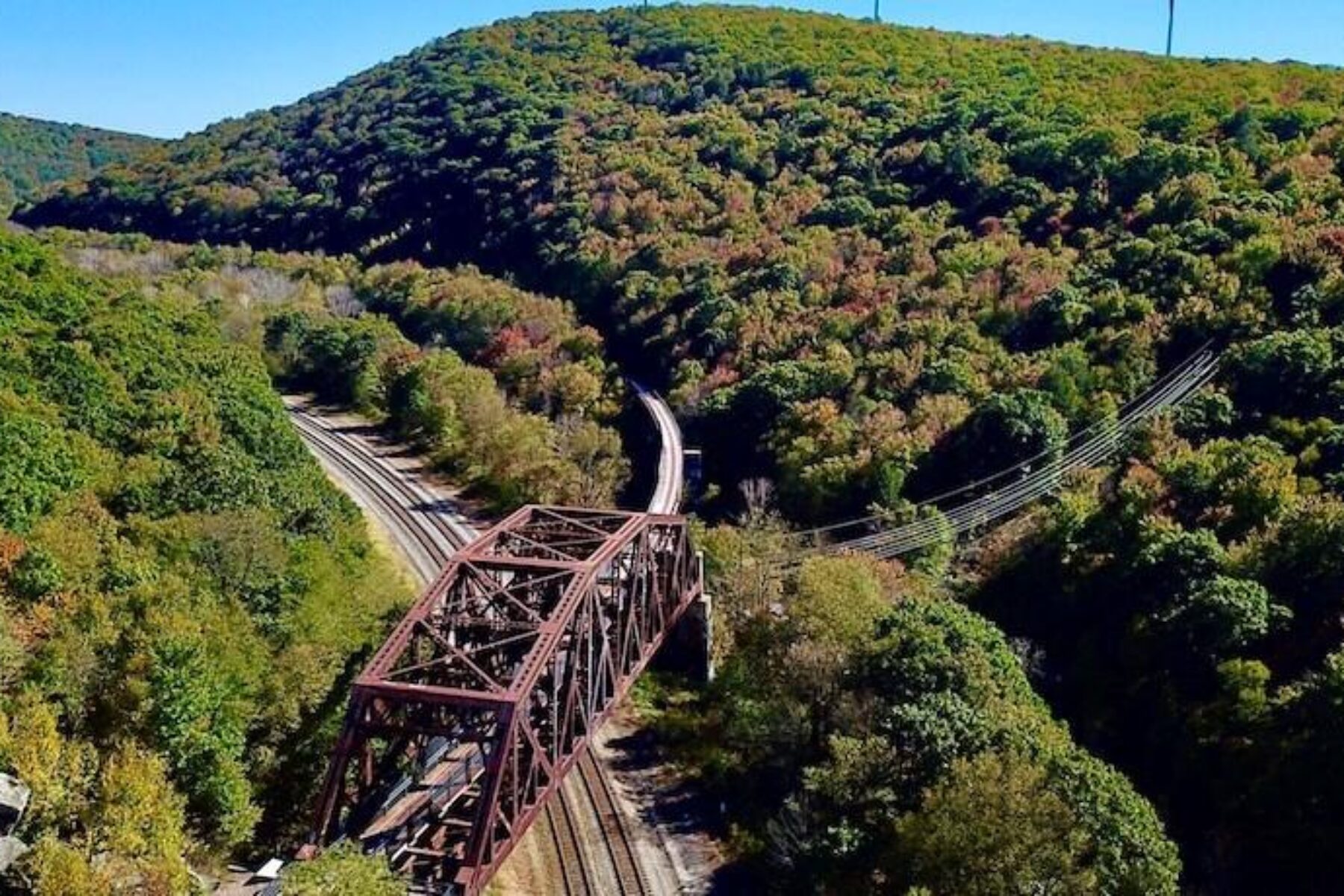
Since its formal inception in the 1990s, the 150-mile Great Allegheny Passage (GAP) (gaptrail.org) in Southwestern Pennsylvania and Western Maryland has gone from a vision to a premier rail-trail destination in the United States.
The effort would take nearly two decades, but the results, achieved on a cascading tidal wave of collaboration, sweat equity and unwavering persistence, would help establish a new tourism identity for the once-great industrial region, and spark a new era of entrepreneurship and ingenuity.
Today the GAP serves as a valued recreation and active transportation asset for communities, and a bucket-list destination for bicyclists and hikers, drawing nearly 1 million visits annually and generating tens of millions of dollars in trail-user spending per year. Completed in 2013, and crossing five counties, the trail’s economic and social impact has been furthered by investors willing to take a chance on a new type of progress, and people who saw an opportunity—spurred by the trail—to bet on themselves.
The story of the GAP is one of vision, tenacity and transformation. But at the heart of it all, it is the story of what’s possible when people come together with a great idea.
Great Allegheny Passage Quick Facts
Since its inception in the 1990s, the 150-mile Great Allegheny Passage (gaptrail.org) has helped transform communities in Southwestern Pennsylvania and Western Maryland.
Length: 150 miles
Counties: Pa.: Allegheny, Fayette, Somerset, Westmoreland; Md.: Allegany
Endpoints: Point State Park near Commonwealth Pl. and Liberty Ave. (Pittsburgh, Pa.); and Chesapeake & Ohio Canal National Historical Park at Canal St. and Harrison St. (Cumberland, Md.)
Trail Uses: Walking, biking, wheelchair accessible, horseback riding, cross-country skiing
The Great Experience
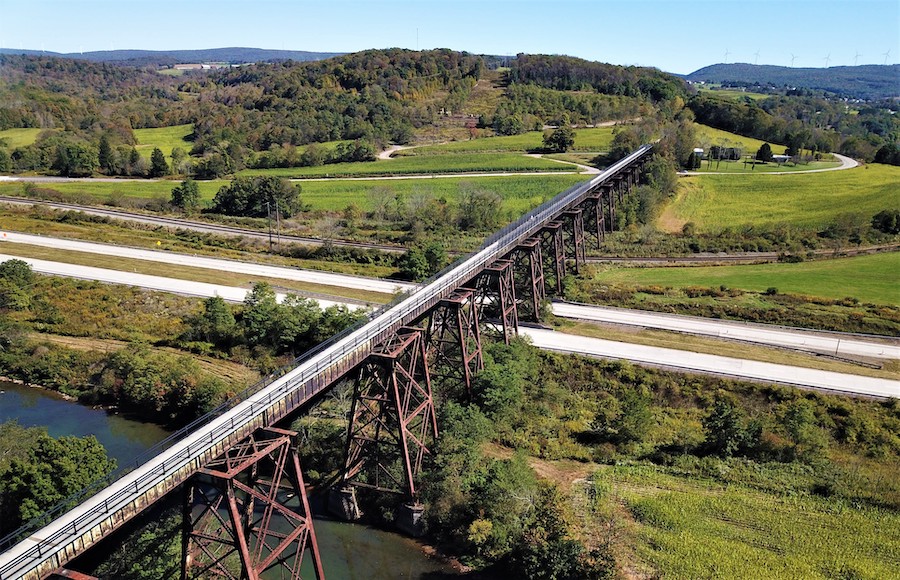
By industry standards, the GAP is what rail-trail dreams are made of: a major urban center as its western focal point; a historic town at its eastern base that caters to trail users; sprawling landscapes; expansive bridges and tunnels; and relics encapsulating the region’s history, from the days of George Washington, to its past heyday as an American industrial powerhouse.
About 15 communities line the route—many of them former coal, iron and steel enclaves that have embraced a new calling in the post-Industrial Age as trail towns.
“You are tracing George Washington’s footsteps from the 1700s, and old industry, from coal mining to coke manufacturing—from American independence to the Industrial Revolution. And these towns are great at telling their own stories,” said Bryan Perry, executive director of the Allegheny Trail Alliance (ATA), the coalition that created, and now supports and promotes, the GAP.
At its western terminus is Point State Park (mile 150) in Pittsburgh, where the trail makes a congruent link with the 24-mile Three Rivers Heritage Trail. The park marks the former site of two prominent mainstays of the Seven Years War—Fort Pitt and Fort Duquesne—and it was during the war that Lt. Col. George Washington cleared the difficult route later known as Braddock’s Road, between Fort Cumberland and the Ohio River, part of which the GAP now follows.
Related: Riverfront Resurgence: Pittsburgh’s Three Rivers Heritage Trail
Homestead’s historic Pump House and early-20th-century coke ovens in Connellsville remind trail users of industry days. And at the state border, the trail crosses the Mason-Dixon Line, which represented freedom for tens of thousands of people escaping slavery in the 1800s.
In McKeesport, trail users can take a 5-mile section of U.S. Bicycle Route 50 to connect with the Montour Trail in Clairton. And at the trail’s eastern terminus in Cumberland, Maryland (mile 0), people can connect with the 184.5-mile C&O Canal Towpath for a seamless 334.5-mile route between Pittsburgh and Washington, D.C.—an iconic journey drawing bicyclists from around the world.
The GAP also serves as a host trail for the 1,300-mile September 11th National Memorial Trail linking three national memorials, and the 3,700-mile developing Great American Rail-Trail™ connecting 12 states and D.C.
Thirty bridges and trestles, and four tunnels, line the GAP. These include icons like the 101-foot-high Salisbury Viaduct near Meyersdale; the Pinkerton High Bridge over the Casselman River; the 130-year-old Pinkerton Tunnel spanning 849 feet in Markleton; and the 3,249.6-foot Big Savage Tunnel, a product of an ambitious renovation.
“We have people that come from all over the country and overseas that cycle and walk the GAP; it’s a recreational and tourism asset that’s complete, with connections to major cities. The trail system goes through a lot of trail towns … it’s a transportation corridor as well. It’s a great regional resource,” said Darla Cravotta, secretary of the ATA Board of Directors, and director of community relations and special projects for Allegheny County, who helped complete the GAP.
And then there’s the view—encapsulated in the Laurel Highlands, a 3,000-square-mile region in Fayette, Somerset and Westmoreland counties famous for its watersheds and foliage-lined viewscapes. This includes the 20,633-acre Ohiopyle State Park, known for its camping, whitewater and proximity to renowned architect Frank Lloyd Wright’s Fallingwater and Kentuck Knob.
“There is an economic component to the trail, but that goes hand in glove with the idea that it’s a beautiful—really beautiful—recreational and conservation resource that’s protecting major pieces of our viewsheds,” added Cravotta.
A Great Collaboration
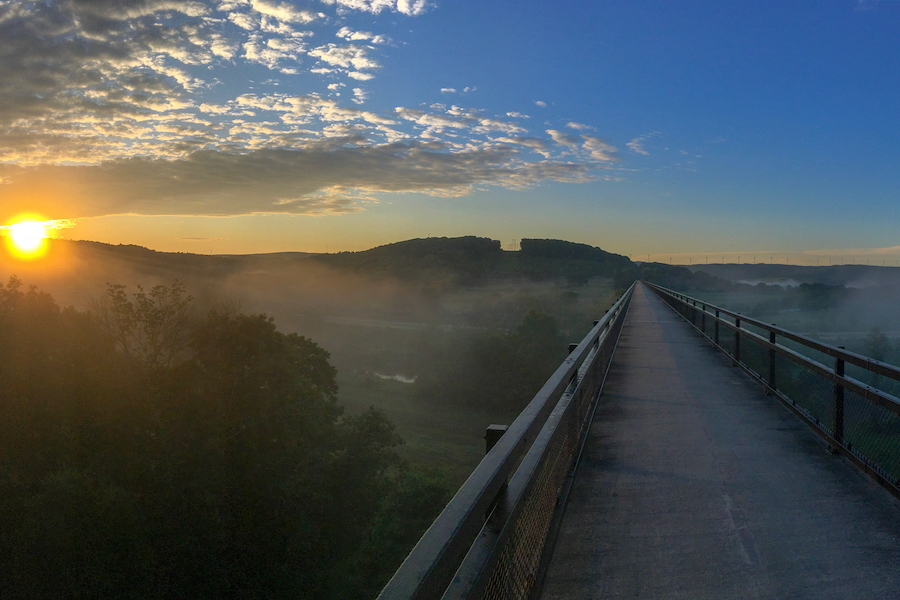
The GAP predominantly follows two former railroad corridors, the Western Maryland Railway (WM) and the Youghiogheny Branch of the Pittsburgh & Lake Erie Railroad (P&LE), which fell into disuse in the 1970s and 1980s, respectively.
The trail’s origins trace back to June 9, 1978, when the Western Pennsylvania Conservancy purchased 26.7 miles of WM right-of-way in Fayette County for Ohiopyle State Park. The first 9.5 miles were completed in 1986 as the Youghiogheny River Trail.
But those familiar with the story of the GAP’s formal development affirm that it really begins in the 1990s with a woman named Linda McKenna Boxx.
Boxx, who chairs the Katherine Mabis McKenna Foundation as her day job, was fundraising for a local trail when a railbanking issue led her to seek advice from the Regional Trail Corporation, which invited her to join the board and its fundraising committee in 1993. It was during their efforts to fundraise for the Youghiogheny River Trail (North) that the vision of the GAP—spurred by the notion of a connection with the C&O Canal Towpath and, ultimately, the nation’s capital—began to grow in Boxx’s mind.
“I found it awkward to keep saying to funders, “‘Yough River Trail—North, and Yough River Trail—South,’” Boxx stated. “I was asking myself, ‘Why are there two trails? Why not one?’ As people talked about the opportunity to connect the region’s trails leading to D.C., we started to say, ‘[Let’s see] if we can make this actually happen.’”
In 1995, at the behest of Boxx, Somerset County expanded its trail summit to include trail groups between Pittsburgh and Cumberland. Soon after, seven primary groups along the projected route formed a task force and tucked themselves under the Regional Trail Corporation. The Allegheny Trail Alliance was born.
It would spur a coordinated mass collaboration—of trail advocates and champions, funders, volunteers, corporations, municipalities, counties and two states—the likes of which had never been seen before. It’s here that Boxx got on what she calls “the fast train” for two decades of “keeping the money coming in”—with her and her colleague Jim Linenberger serving as a “dynamic duo,” knocking on the doors of foundations and agencies in a whirlwind of travel between Harrisburg and D.C.
In addition to the D.C. connection, the group had another primary goal: to create a new economic driver for the region. But sacrifices would need to be made.
“It was hard for some,” said Boxx. “But we realized, if we really want this, to be able to show the return on investment, if we’re going to get it done and have people understand what they’re getting, it had to have one name.”
They adopted a new moniker: the Great Allegheny Passage.
Completing a Great Regional Asset
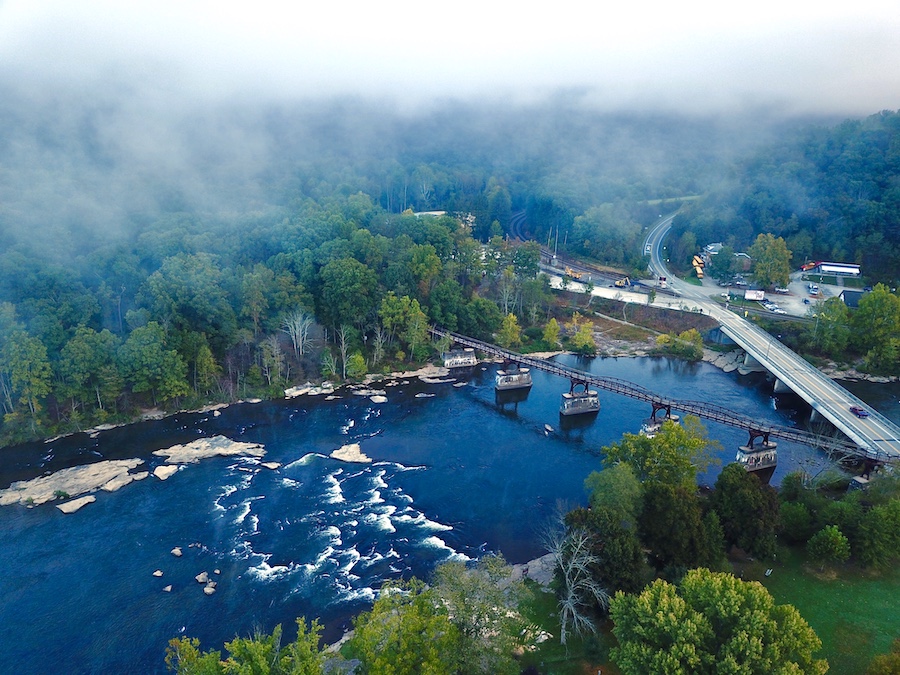
To help complete the $80 million project, critical support came from champions like Pennsylvania Governor Tom Ridge, Secretary John Oliver of the Pennsylvania Department of Conservation and Natural Resources (DCNR), and State Rep. Rick Geist, chair of the House Transportation Committee.
Pennsylvania included millions of dollars in its capital budget, and significant funding came from the Transportation Enhancements (TE) program (now known as Transportation Alternatives) via the 1991, 1998 and 2003 federal transportation bills.
The first major priority was the renovation of the longest tunnel on the route, the Big Savage Tunnel, a massive $12 million project completed in 2003 and considered a linchpin for a connection with the C&O Canal Towpath. For the tunnel, the DCNR “sought funding from as many sources as possible,” said Diane Kripas, chief of the Partnerships Division, specifically noting Pennsylvania State Capital budget funding and $2 million creatively acquired through the federal Land and Water Conservation Fund as part of the $11.5 million ultimately invested by the DCNR.
The final challenge was the build-out of the GAP in Allegheny County to its terminus at Point State Park—which included two new bridges over Norfolk Southern’s main line and a 0.8-mile section skirting Sandcastle waterpark that would be wrought by negotiations lasting decades, and would seal the GAP’s completion in 2013.
In 2008, Pittsburgh’s 250th anniversary hit, leading corporate leaders to prioritize the GAP as a project of regional significance, and generating political support from titans like Norfolk Southern and U.S. Steel.
Today, as the state looks to complete other projects—such as the ambitious 165-mile D&L Trail—the GAP serves as a poster child for what’s possible. “This was done when NIMBY-ism [not in my backyard] was in full swing,” said Kripas. “A lot of what we learned is because of our ‘mother of long-distance trails.’ Now we have proof that it can be done.”
Note: When discussing GAP history for the article, many other names were mentioned, including Ohiopyle State Park Superintendent Larry Adams, Pittsburgh Mayor Tom Murphy, Hank Park of Somerset County and Rails-to-Trails Conservancy Co-Founder David Burwell. To name everyone here is impossible; to that end, the Regional Trail Corporation is documenting the trail’s extensive history, with plans to publish it online in 2020 and update it as new information becomes available.
Inspiring the Great American Rail-Trail
The Great Allegheny Passage (gaptrail.org) is a host trail for the 3,700-mile Great American Rail-Trail™, a developing cross-country route connecting Washington, D.C., and Washington State, and featuring some of America’s most iconic landmarks.
As Rails-to-Trails Conservancy (RTC) and partners work to complete the Great American, the GAP serves as inspiration.
“The GAP is a vanguard of spine trails. It brought interesting and impactful trails together and showed how they could create an impact more powerful than the sum of their parts,” said Eric Oberg, director of RTC’s Midwest Region. “The trail is now a national model for the Great American and for trails across the country—of how to spark tourism in areas that might not otherwise be destinations—essentially transforming the economic fabric and collective regional identity of these communities.”
Great Destinations
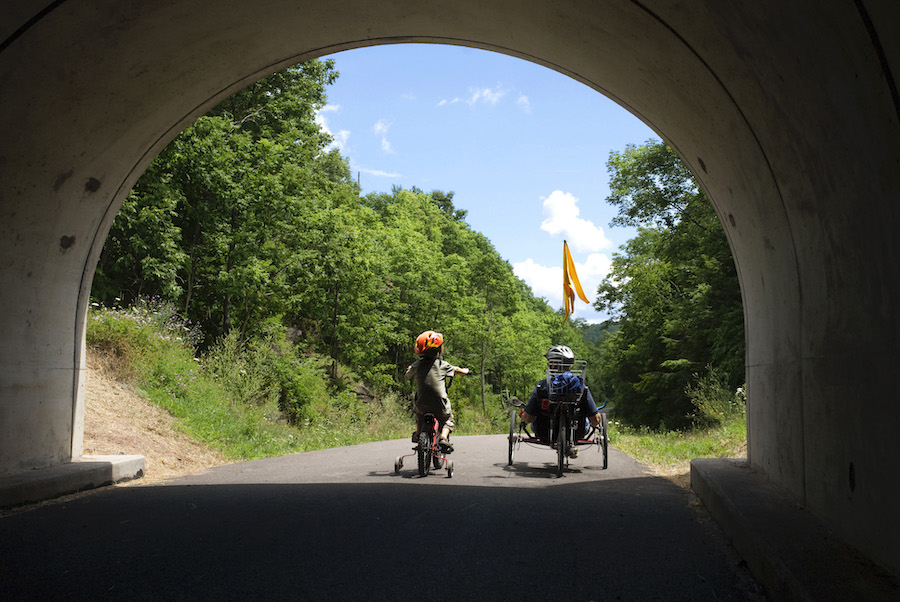
In the early years, there was a lot of excitement among developers, but also skepticism on the part of locals, about the trail’s potential impact.
“People asked how a bike trail would make up for the loss of industry,” said ATA Board President Brett Hollern, who worked on the GAP for some two decades in Somerset County, and currently serves as the program manager for trails & recreation at the Pennsylvania Environmental Council. “The reality now is that when people talk about trails and economic development, they use the GAP as a [standard].”
A 2019 trail-use study recorded 989,455 visits (mid-range), and an economic study in 2012, before the GAP’s completion, found an economic impact of $40 million per year. Though a majority of the trail’s visits come from day users—between 89% and 94%—thru-riders accounted for more than 63,000 visits in 2019, demonstrating the trail’s popularity with tourists.
According to the Laurel Highlands Visitors Bureau, the GAP is used by riders from all 50 states, and serves as a destination for the international market, with 34 different countries represented last year.
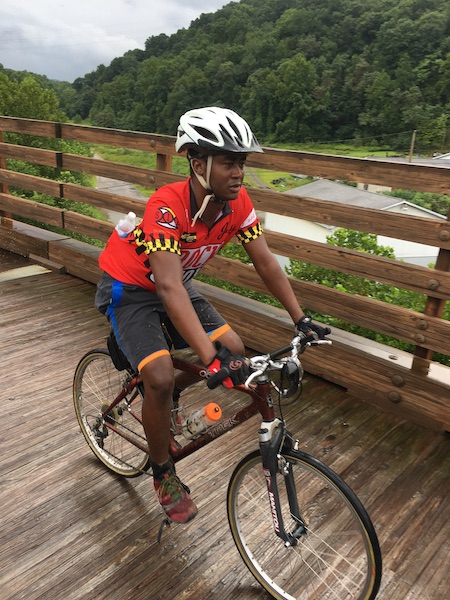
For ATA’s Perry, the GAP’s iconic nature is attributed in large part to the fact that the GAP is a destination connected by great destinations. “Pittsburgh is a world-class city with every art and outdoor experience you’d want … and Cumberland is a quintessential trail town. And when you combine the GAP with the C&O Canal Towpath—you’ve got a great ride between Pittsburgh and D.C.,” he said.
Towns along the GAP are also spaced out in intervals, between 10 and 20 miles apart, and each one has services—a place to sleep, a place to eat—to lighten the load.
Cumberland—the “meeting place” for the GAP and C&O Canal Towpath, which has Amtrak and a connection to the National Road—has embraced its bicycling identity, with signage for trail users, a full-service bike shop, and attractions including a distillery and a brewery.
Confluence, which is located near Mount Davis and contains fewer than 1,000 people, had one restaurant and one bed-and-breakfast before the GAP was completed. “Today, the town boasts four restaurants, 20 lodging properties and a full-service bike shop,” said Perry.
He added, “You’re never more than an hour away from ice cream or a hamburger or a soft mattress. It gives you a sense of safety and possibility.”
In 2014, when Denise and Charles Gehringer bought an apartment building with a few overnight rooms in Meyersdale, Pennsylvania, population just over 2,000, they knew the previous owners rented to bicyclists, but hadn’t considered the trail’s full business potential. It was the beginning of the season, however, and Denise said they “quickly realized how significant the riders on the trail seeking overnight stays would be.”
The demand got so high, she affirmed, that they even started taking bicyclists home when their business was full and other rooms weren’t available. Over the last six years, they’ve expanded to 12 rooms, and today, Yoder’s Guest House does about 95% of its business from trail users, with 1,200 reservations on a good year.
“The trail has helped immensely,” said Charles. “For these riders to be able to ride the [trail] through a town that isn’t seeing people come through on a day-to-day basis otherwise—it’s had a huge impact.”
Melissa Friend-Blocher, owner of a third-generation family business in Meyersdale, Donges Drive-In & Motel, says the town dubbed “Maple City, USA” for its production of syrup, candy and related products is embracing its trail town moniker.
A renovation of her seven-room motel was influenced by trail users—and her diner’s burgers, pancakes and maple syrup, provided by her husband’s third-generation family maple sugar camp, Milroy Farms, are popular with locals and bicyclists alike. There are formal efforts being implemented by the Meyersdale Area Merchants’ Association, including vintage bike displays, to welcome trail users, and local businesses recently acquired some $50,000 in tourism grants from Somerset County to help with marketing.
It’s an effort, she says, that is led by a close-knit community good at supporting one another—and being kind to its bicycling community, too.
A Great Ride
Impact of COVID-19 on Local Trail Communities
As of May 2020, many small businesses along the Great Allegheny Passage and on trails across the country are experiencing catastrophic losses in patronage as a result of the COVID-19 pandemic. The Allegheny Trail Alliance (ATA) is communicating with business owners and is monitoring the situation to determine what support and resources may be vital as communities seek to recover from this economic and health crisis.
The ATA urges all those planning trips (after stay-at-home and social-distancing mandates are over) to call ahead to ensure restaurants and bed-and-breakfasts are ready to receive customers.
For information on safe trail use during the pandemic, go to Rails-to-Trails Conservancy’s COVID-19 Resources page.
The thru-ride between Pittsburgh and D.C., and the evolution of tour groups and trip planners, has served to increase the trail’s popularity and patronage.
Eric Martin, co-owner of Wilderness Voyageurs, a whitewater, climbing and bicycling outfitter founded by his father in 1964, remembers when the older Martin was involved in bringing the first section of trail through Ohiopyle—which then had a population of about 80 people (50 now)—and the impact it had on their business.
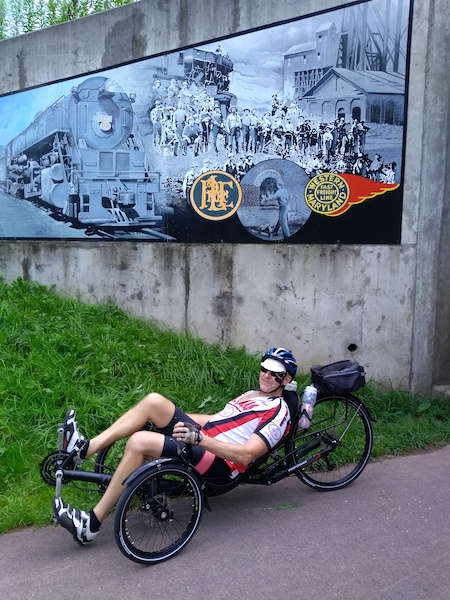
“We had a fleet of 12 BCA Cruisers that first year. Fast forward, our daily rental now is 125 bikes,” said Martin. He continued, “In the mid-1990s, we began weekend bike tours … but we weren’t super successful until more and more miles of the GAP were completed, and people began to look to us for more and different services, like multiday bike rentals, shuttles and pickup. By virtue of what we did, we became bike-tour experts for the GAP, and that really [gave us momentum].”
Today, bicycling is Wilderness Voyageurs’ largest division, offering multiday trail rides on 20 rail-trails, including three GAP itineraries.
Martin credits The Progress Fund and its Trail Towns Program® for supporting the growth of his business, to the tune of $2 million to date, and he extolls the fund for its willingness to invest in ideas by small entrepreneurs that other banks might view as a risk. “They know small-town entrepreneurs need help, but may not have any assets up front,” said Martin. “They are investing in people and ideas.”
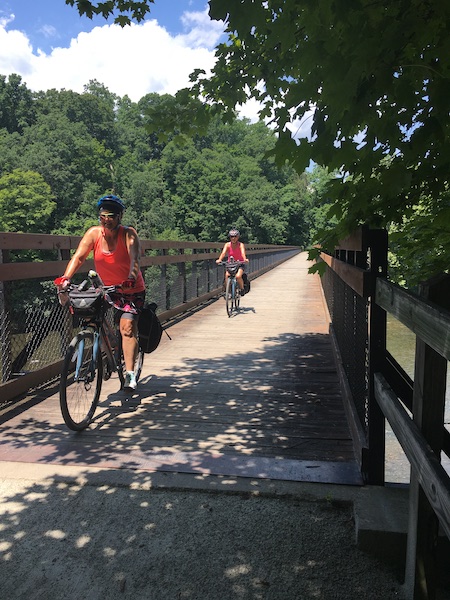
Near the GAP’s western terminus in downtown Pittsburgh, Tom Demagall, owner of Golden Triangle Bike, would see his business similarly evolve from a rental service of about 20 bikes 14 years ago to a full trip-planning service—from shuttles and drop-offs to hotel and flight bookings—with an estimated 300 bikes today.
According to Demagall, he initially set out to do rentals and guided city tours, but after several years, the calls about thru-riding started coming in. “The GAP overtook the whole point of the business,” he said. “We learned how to accommodate long-distance bicyclists, and how to plan bike trips. It was a big shift, and we were open to it.”
Today, 90% of Golden Triangle Bike is focused on trip planning; Demagall estimates that last year alone, they accommodated 800 people, 90% of whom flew in to use their services. “The work that the ATA has done … it’s all come to fruition … and it’s made this trail a unique self-supported option for people, “said Demagall.
Perhaps that’s why so many people return, year after year.
“The GAP is not a one-and-done tourism attraction,” affirmed Ann Nemanic, executive director of the Laurel Highlands Visitors Bureau. “Thru-riders return annually. Others share their story and return with friends and family. First-timers become keenly aware that there is so much to do within a short distance of the trail.”
Great Champions, Great Challenges
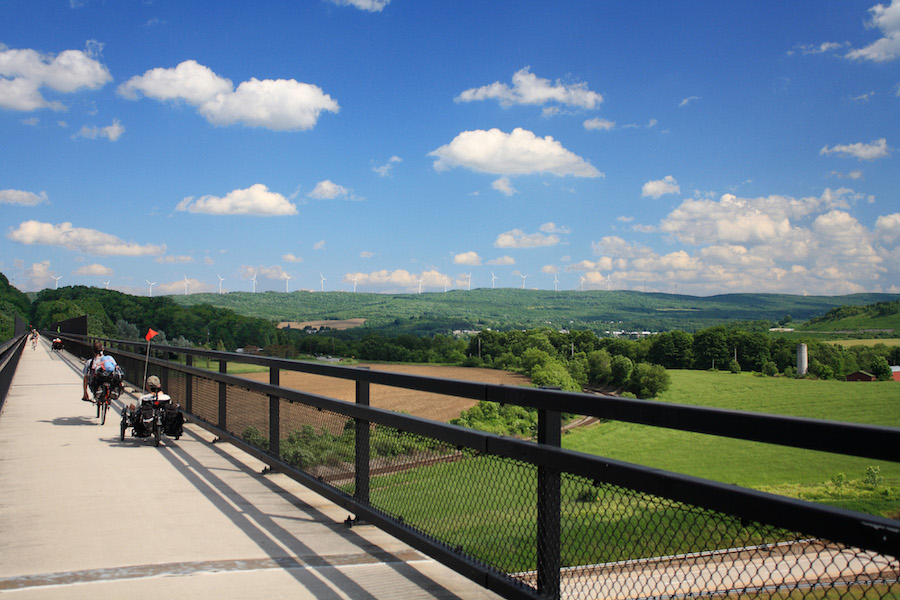
The story of the GAP doesn’t end here.
As the trail goes full-steam ahead, there are other champions who carry the torch: the many local residents—95% of whom are volunteers—who maintain different sections of the GAP with leadership and support from the counties, the city of Pittsburgh and the Regional Trail Corporation.
“Our volunteers take incredible pride in maintaining [the trail],” said Jerry Green, board president of the Steel Valley Trail Council, which focuses on a section of the GAP between McKeesport and Pittsburgh. “We’ve got five or six guys who go out early every Wednesday morning and work like crazy, keeping up with grass cutting, weed control and fence-mending. They’re just like volunteer firemen, too. Every time a tree falls. Every time the mud slides. They own it. They take care of it.”
Green estimates that the group clears drains weekly, and trail-closing landslides and fallen trees at least monthly. In early 2020, they even organized an effort to clean graffiti from a 60-foot section of a 20-foot-high wall.
But challenges remain, and the biggest, for the ATA and for volunteers, is the lack of central maintenance funding. Perry specifically notes the impact of climate change—2018 was the wettest year in Western Pennsylvania, generating four landslides—and his concerns about when volunteers who have been stalwart for decades retire.
“One of the great things about the GAP is the quality of the ride,” said Perry. “It’s smooth and wide and lovely and accommodating for any type of bicycle, and riders of any [age or] background. We want to make sure it’s sustainable in the long term.”
Events like the Great Allegheny Passage Relay (run by P3R, who also operates the Pittsburgh Marathon) help bring in funding, as do sales of the ATA’s signature “TrailGuide”; however, “there is no magic wand,” said Perry, and maintenance funding remains a top priority.
“I like to say that 2013 is when we completed the trail, but we’re not finished with the Great Allegheny Passage,” said Cravotta, who served as ATA’s board chair for nearly five years. “Now, it’s about preserving this legacy that began 30-plus years ago.”
Moving forward, the ATA has plans to reach out to new and diverse audiences, and to encourage patronage in the towns along the GAP so businesses can flourish. They are also set to launch a new economic impact analysis that will serve as a resource for trail towns in the future.
But what’s evident now: The magnitude of the GAP’s impact over the past several decades has resonated far and wide, around America and across the nation.
“I feel so fortunate to have fallen into this project,” said Boxx. “It consumed a lot of my life … my sons were little when I started it, and they graduated from college before it was done. But we got it done, we did what we set out to do, and it’s had such a powerful impact on our whole region. It has transformed communities.”
This article was originally created for the Spring/Summer 2020 issue of Rails to Trails magazine. It has been reposted here in an edited format.

Donate
Everyone deserves access to safe ways to walk, bike, and be active outdoors.



